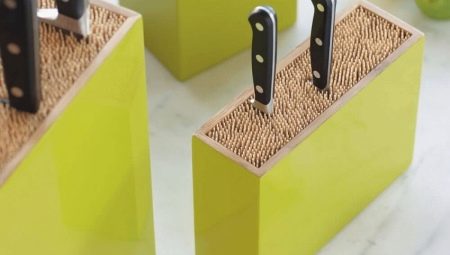If at home, preparing a meal, the hostess does not immediately think about organizing kitchen utensils, including knives, then, for example, in a restaurant or hospital kitchen, where frequent cooking is set in a fast flow, serving a huge contingent every day, every little thing matters. To work more efficiently and faster, chefs contain knives, electrical appliances, cutting boards and other utensils in an easily accessible order - as their working regulations prescribe.
Working in shifts, not every cook will like it if the previous worker, whom he just replaced, left the same knives in one of the drawers of the table without having them laid out in a special stand or in a pencil case in a prominent and well-known place. And when there is no way to buy such a stand overnight, it makes sense to take care of its independent manufacture.

What is included in the design of the stand?
As bearing capacity any ready-made or home-made container, box will do. The latter is made of plywood and / or rail. As a ready-made container, a filter jug for water is often used, in which the liner that holds the replaceable filter cartridge has broken.
In addition to the carrying capacity, it should be located reliable filler. The height of the container and the level of the filler are such that the knife inserted with the tip down immerses in the filler along the handle, without reaching the bottom of this container with the tip of the blade.
Accordingly, the filler is selected so that the knife stably stands in the stand, not falling over to adjacent knives or to the edge of the stand itself. The filler itself should not move when the stand is stationary.


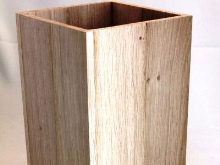
The best filler material
Jelly-like material is unsuitable as a filler - it will stain the just washed knife, put into storage. Loose is also not an ideal solution: you are unlikely to want to leave knives, for example, in a saucepan with buckwheat or sugar.
The best solution is sticks or pegs whose length is substantially greater than or equal to the height of the container: being folded together and squeezed in an amount that leaves a little free space, they form an almost ideal “landing” platform for a dozen knives. If only one of several knives is currently inserted, it should not fall into this free space with the handle.
When all the knives are inserted into this makeshift stand, the sticks and pegs are pressed against each other and to the knife blades tight enough to prevent the latter from falling to one side.
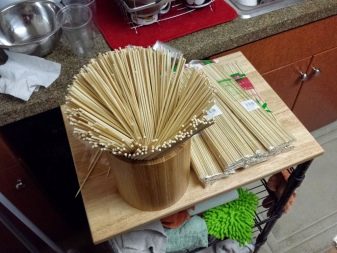

Filler sticks
In addition to sticks chopped in large quantities from fresh firewood or cut from thin branches of any tree, bamboo can also be used, which are sold in any hardware store or for needlewomen. Instead of sticks, for example, aluminum wire (you can pull the "cores" out of the old cable), cut into the same length by segments dulled from the ends, is permissible.
If there are no bamboo sticks, dissolve a new broom and cut its rods appropriately.
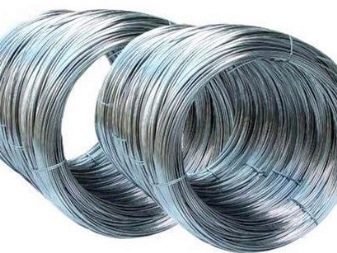

Other material
If no sticks were found, strips of thick cardboard, old magazines rolled up in a roll, candles, bristles of plastic brushes and even books can be used as filler. The latter can either fit in a ready-made container (or a box independently made for them, for example, designed for several volumes from a collection), or act as a supporting structure (hardcover covers are material for cells, and pages can filler).
To make the stand purely from old books, tie 3-4 volumes with decorative tape and set it vertically - such a stand is ready to accept its first knives for storage.
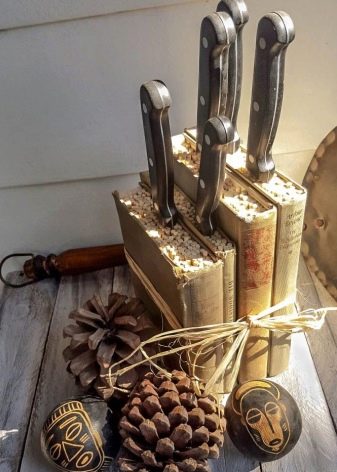
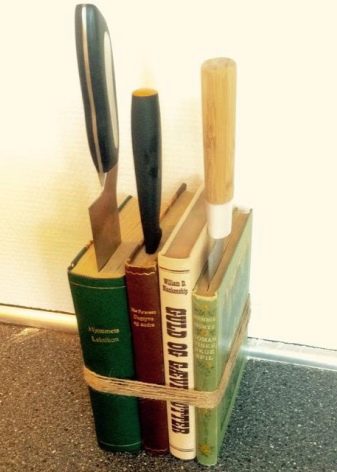
Brush bristle option
Purchase at least two ready-made plastic brushes and a PVC pipe with a plug up to 20 cm in diameter. You will also need epoxy glue. Step by step the whole manufacturing process is as follows.
- Saw off the butt end at one end of the pipe.
- Pull the bristles out of the brushes and put them together.
- Pour glue into the cap so that it spreads evenly along the bottom of the cap at least a centimeter, and insert the collected tufts of bristles into the cap. Glue impregnates their ends and after hardening reliably holds the bristles in the cap. If hot-melt adhesive is used instead of epoxy, the bristle tufts are glued one at a time or in small groups. The bristles should be as tight as possible.
- After hardening, drag the glued bristles through a piece of pipe. Connect the structure together by closing the plug. For stability, you can glue a piece of square plywood of a larger size to the plug than the diameter of the plug itself.
The design is assembled and ready for use. The bristle hairs are a dense wall and can reliably hold even several inserted knives.
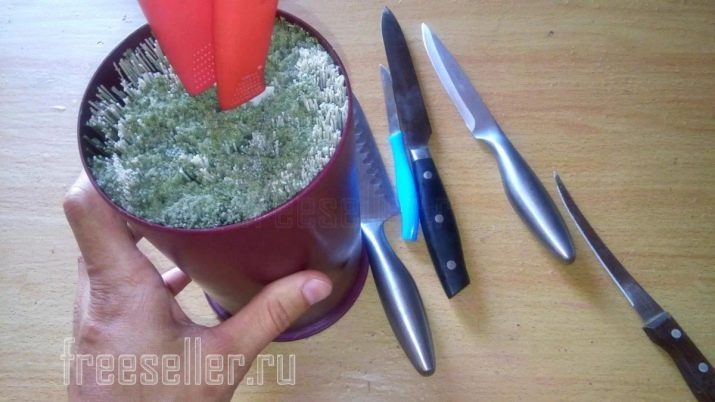

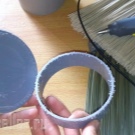


Unfilled stand
The simplest option is any wooden block with a width or diameter of at least 20 cm. After sawing wood (both for firewood and industrial for construction purposes), a piece of wood with a height equal to the blade length of the longest knife from your set. Using long drills, a jigsaw or other improvised tools, slit-like holes are made in it, each of which will fit any of the knives.
If you are dealing with thin rails or plywood, then an oblong piece of plywood or a piece of rails at least 1.5-2 meters long is enough to make a stable stand that will not fall, even when the largest and heaviest knife (usually a cleaver for chopping carcasses) is inserted close to the edge.
The design can be as simple ("as logs"), and take a tricky form.

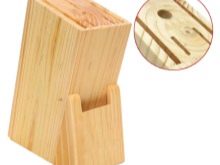
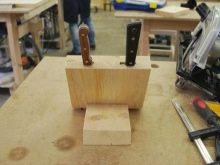
Hanging stand
If the design of your kitchen is so advanced and perfect that the quick ways to make a stand will only spoil the look, use the option that is not inferior to industrial products in terms of accuracy or quality. To make the stand you will need:
- a board equal in length and width to the future stand;
- rail or plywood;
- glue or screws.
Do the following:
- mark the board in accordance with the location of the horizontal and vertical sections of the staff;
- glue thin (slightly thicker than the blades of the largest knife) pieces of rail to the board (there are several of them) in accordance with the marking parallel to the inserted knives;
- then glue three longitudinal (perpendicular to the previous) segments - two along the edges and one in the middle.
The resulting design can be supplemented with lateral struts or legs that prevent it from falling, or fixed on the wall by attaching two additional rails to the latter.
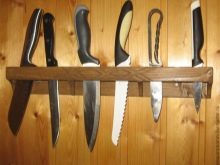


The second version of the hanging stand is much simpler. In any rail or bar, a groove is cut out into which small neodymium magnets are inserted, fixed with glue. The design is hung on the wall or, for example, the side of the kitchen cabinet. It is enough to attach the knives with blades to the places of magnets - they reliably hold on them. Such a magnetic holder is the best solution for knives, which there is no need to wipe due to the huge number of repetitive actions when cooking is set on a wide stream.
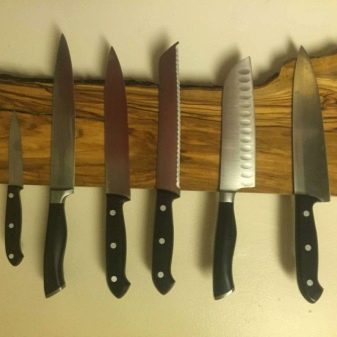
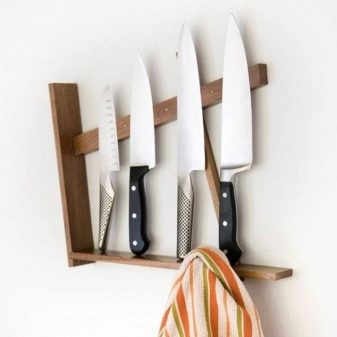
Multi-rail desk stand
Another “advanced” option for the arbitrary arrangement of knives in the stand, giving the kitchen its own, unique element of luxury.
The step-by-step manufacturing process is as follows:
- cut the rail into dozens of segments equal in length, but 1-2 cm longer than the largest knife of your set;
- draw the base of a square or rectangular section of the board or plywood along the cross section of the rail;
- glue the edging of long and narrow sections of plywood around the perimeter - this will create a fixing edge on all sides;
- vertically arrange the pieces of the rack and fix them with nails, after applying a layer of glue to their ends and to the seats of these segments;
- let the whole structure “grab”.
For reliability, if the distance equal to the blade of the longest knife allows, epoxy glue is poured. The latter has excellent fluidity, and 1.5-2 hours before hardening, it will have time to leak into all microcracks, small cracks remaining after the main stage of work.
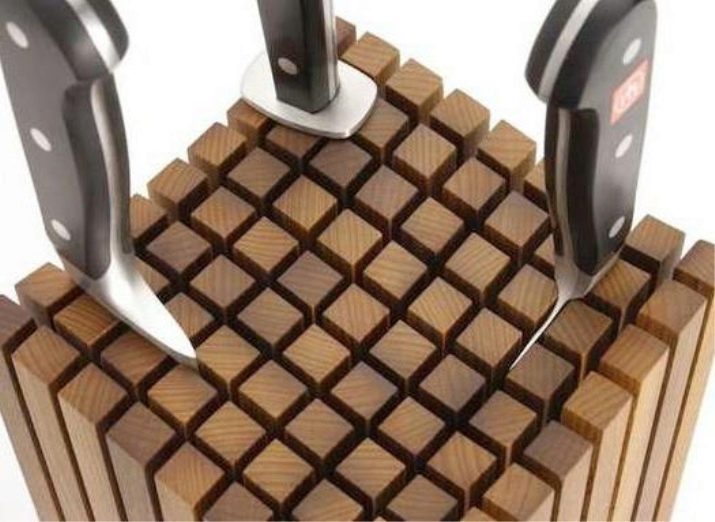
There are more than a dozen ideas for do-it-yourself do-it-yourself knife stands, not inferior to industrial ones. Many “do-it-yourselfers” make good money on this, because the manual work of a master who is well versed in the fashion of modern decor is more valuable than conveyor manufacturing of parts or automatic assembly of a product into a consumer-boring design, replicating millions of pieces a year.
See how to make a knife stand with your own hands in the next video.
